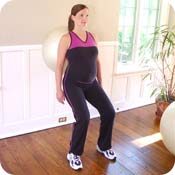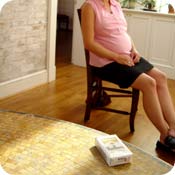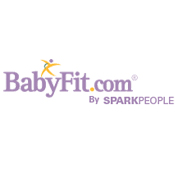 There was a time when exercise during pregnancy was discouraged--but not anymore! Times have changed, and experts now encourage exercise during pregnancy.
There was a time when exercise during pregnancy was discouraged--but not anymore! Times have changed, and experts now encourage exercise during pregnancy. In 2002, the American College of Obstetricians and Gynecologists began recommending that pregnant women should exercise moderately for 30 minutes most days, if not every day (unless there are medical reasons prohibiting it). Exercise benefits mom by: 
Exercise benefits baby by:
The exercises you can do during pregnancy depend on two things: your current health and how active you were before pregnancy. If you were not active before, don't use pregnancy as the time to begin a strenuous fitness regime; if you exercised before pregnancy, you can continue your program with some slight modifications. Before you begin (or continue) any exercise program, discuss it with your health-care provider. Together, the two of you can plan an exercise program that is consistent with your current level of fitness and sensitive to any current health conditions. It is mandatory that you consult a health care professional first, especially if you have any of these conditions:
NOTE: If you experience problems such as bleeding, premature labor, dizziness, severe abdominal pain, or unusual fatigue during or after exercise, you should stop immediately and contact your healthcare provider before continuing. Warm Up and Cool Down  When you're pregnant, extra blood flows to your uterus and unborn child as a first priority. Although there's plenty of blood to go around, exercising requires additional blood as well. This is why it's so important to warm up before you work out. To help meet the muscles' increased demand for oxygen and blood, take 5 minutes to slowly build up your intensity and increase your heart rate before exercise.
When you're pregnant, extra blood flows to your uterus and unborn child as a first priority. Although there's plenty of blood to go around, exercising requires additional blood as well. This is why it's so important to warm up before you work out. To help meet the muscles' increased demand for oxygen and blood, take 5 minutes to slowly build up your intensity and increase your heart rate before exercise.
Cooling down when your session is over is just as important because abruptly stopping any exercise can lead to dizziness, faintness, and increased muscle soreness. Spend another 5 minutes cooling down by slowly decreasing your intensity to return your heart rate back to its resting level. What is a Kegel? Your pelvic-floor muscles act as a sling for the bladder, uterus, and rectum. Kegel exercises play an important role in helping you heal and recover after labor. Kegels help keep your pelvic-floor muscles strong during pregnancy, help get them back in shape after delivery, and possibly prevent urinary incontinence. How to do a Kegel: Exhale and tighten the muscles in the walls of your vagina, pulling upward and inward; count to 3 and inhale as you relax. Repeat for a total of 5 repetitions. Do 5 sets, 3 times per day. Gradually work up to holding each Kegel for a count of 10. (If you have difficulty with figuring out if you are doing it right, practice by stopping your flow of urine.) Once you are able to do Kegels, incorporate them into your abdominal exercises and lower body moves.
Moderate Means Moderate In the past, experts suggested monitoring your heart rate during exercise, similar to how you would when you are not pregnant. However, new research suggests that heart rate isn't an accurate way to measure intensity during pregnancy. Accordingly, the ACOG has lifted the restriction of the heart rate cap of 140 beats per minute. When you're pregnant, your heart rate is already increased, and it is more sensitive to changes. For example, light walking may make you feel winded when you used to be able to jog. Experts now suggest using the Rate of Perceived Exertion (RPE) Scale, also called the Modified Borg Scale. This scale ranges from 1 to 10, and is a self-assessment. When pregnant, you should exercise between level 4 (Somewhat hard) and level 6 (Hard). Do not overdo it. You don't want to become breathless or exhausted. In the proper range, you should be able to carry on a conversation with someone next to you. If you can sing, you may not be exercising intensely enough, but if you are too winded to speak, then slow down. Discuss your exercise intensity and get a recommendation from you healthcare provider beforehand. Aim for three to five 30-minute exercise session each week at this moderate intensity. Click here for a full explanation of the Rate of Perceived Exertion scale. Stay Cool and Comfortable  Be sure to wear clothing that provides comfort and keeps you cool. Comfortable, supportive shoes are necessary, especially if you experience swollen feet. Similarly, you may need to invest in a new, more supportive sports bra. Some women even prefer wearing two sports bras when exercising.
Be sure to wear clothing that provides comfort and keeps you cool. Comfortable, supportive shoes are necessary, especially if you experience swollen feet. Similarly, you may need to invest in a new, more supportive sports bra. Some women even prefer wearing two sports bras when exercising. Staying cool is very important when you are pregnant. For this reason, it's a good idea to dress in layers. Avoid exercising in rooms with poor ventilation and avoid outdoor exercise altogether when it's hot and humid. Remember to drink plenty of fluids to keep your body's natural cooling system functioning properly. As a guideline, your urine should be almost clear if you are properly hydrated. This article has been reviewed by Jen Mueller, a certified prenatal and postpartum finess specialist. |
Pregnancy Fitness 101
Exercise While You're Pregnant
Page 1 of 1

















Member Comments